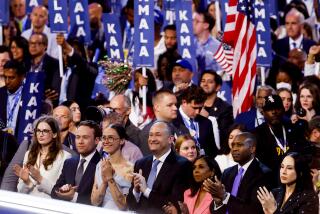‘Faces of America’ reveals family ties
- Share via
Reporting from New York — When Harvard professor Henry Louis Gates Jr. started his latest genealogical project for PBS, which used historical archives and cutting-edge genetic research to trace the ancestry of a dozen famous Americans, he already had one hoped-for outcome in mind.
“I wanted to pick someone who is Jewish and someone who is Muslim and pray we get the same result in their DNA,” he said.
Sure enough, genetic testing revealed that director Mike Nichols, of Eastern European Jewish heritage, and surgeon and television host Mehmet Oz, the son of Turkish Muslim immigrants, had a common paternal ancestor thousands of years ago.
“That is like affirming the story of Abraham,” Gates said delightedly.
The finding is one of the discoveries featured in “Faces of America With Henry Louis Gates Jr.,” a four-part series premiering Wednesday night on PBS. The spinoff of Gates’ series “African American Lives” seeks to tell the story of American immigration by unearthing the heritage of the likes of comedian Stephen Colbert, writer Louise Erdrich, actress Meryl Streep and figure skater Kristi Yamaguchi.
Producers relied on local genealogists as well as the extensive records kept by the Mormon Church to ferret out birth certificates, land deeds and shipping manifests. But perhaps more powerful was the genetic road map in each subject’s DNA. With the help of some of the country’s top geneticists, Gates’ team used technology developed to determine genetic risk for disease to identify each person’s ethnic makeup.
Technological advancements made in the last two years now allow scientists to capture the ancestry of each person’s great-grandparents, rather than just following a person’s maternal line and paternal line, said Anne Wojcicki, co-founder of the genetic testing firm 23andMe. That means distant cousins can be identified. In fact, 11 of the program’s subjects discover they are related.
Aside from revealing intriguing family ties -- including that director Nichols is related to Albert Einstein and that cellist Yo-Yo Ma and actress Eva Longoria Parker are distant cousins -- the program uses the surprisingly entangled relationships to illustrate the interconnectedness of all Americans.
“The message is really that at the heart of human biology and human genetics, our ancestry is all intertwined, and nowhere in the world is that clearer than in America,” said Mark Daly, senior associate member of the Broad Institute of MIT and Harvard.
Gates decided to do another ancestry series after receiving thousands of letters from viewers in response to “African American Lives,” which aired on PBS in 2006 and 2008. While that program focused on tracing the lineage of black Americans, whose ancestors can be difficult to identify because of slavery, he said he was surprised by how many people of all backgrounds asked for help tracking down their forebears.
“I thought, why not experiment and do something bold and try to do the rest of the world?” he said.
He signed up his first subject at a dinner party at Harvard, where he was seated next to Ma, who said his family tree went back only to his great-grandfather.
Gates’ team did much better than that. A Chinese professor who took on the challenge of researching Ma’s heritage visited the musician’s ancestral village and found the entire clan genealogy of Ma’s family, which had been hidden in a wall of a house during the Cultural Revolution so it wouldn’t be destroyed. After the bamboo papers were meticulously restored, researchers followed Ma’s lineage back 18 generations, to the year 1217.
“That is the baddest genealogy story I’ve ever heard in my life,” Gates said.
Oz discovered that a female relative in the 1850s was a member of the sultan’s harem in the Ottoman Empire. He was so taken by the findings -- particularly his connection to Nichols, a personal friend -- that he hired one of the researchers from the series to keep digging.
“The revelation gives the notion of ‘six degrees of separation’ a whole new meaning,” he wrote in an e-mail.
Poet Elizabeth Alexander was stunned to learn that her family tree stretched back to Charlemagne and King John I of England on one side -- and a 2-year-boy sold into slavery in Jamaica on the other.
“I was shocked and ironically amused, because it’s not like I would jump up and down and say, ‘Fabulous, I’m a princess,’ ” she said. “There’s a reason that that heritage is one that was interrupted, and that signals something much darker” -- referring to the “one drop of blood” rule that defined African Americans in the U.S.
“Faces of America” is Gates’ most high-profile project since he was embroiled last July in a heated national debate about race after he was arrested by a white police officer investigating a report of a break-in at Gates’ Cambridge, Mass., home. If there is a message from the series that could be extrapolated to that situation, the African American studies scholar wouldn’t say, declining to discuss the case.
But he was unreservedly exuberant about the implications of the program for a broader understanding of American identity.
“No matter what laws of segregation, the one thing that DNA shows is that when lights came down, we were all getting down,” Gates said. “We are all mulattos.”
More to Read
Sign up for Essential California
The most important California stories and recommendations in your inbox every morning.
You may occasionally receive promotional content from the Los Angeles Times.










